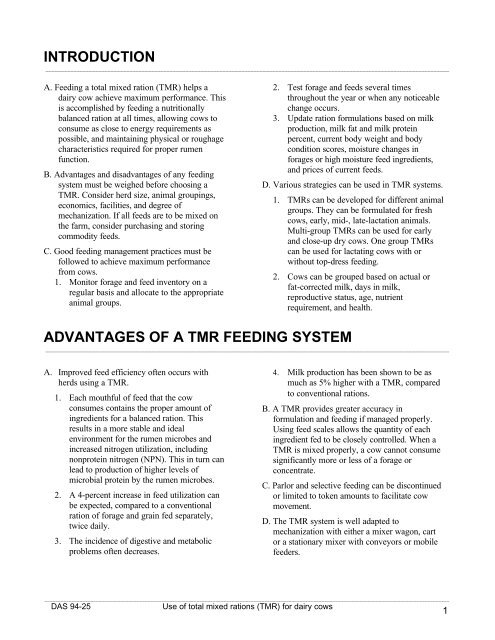Use of total mixed rations (TMR) for dairy cows - Penn State ...
Use of total mixed rations (TMR) for dairy cows - Penn State ...
Use of total mixed rations (TMR) for dairy cows - Penn State ...
You also want an ePaper? Increase the reach of your titles
YUMPU automatically turns print PDFs into web optimized ePapers that Google loves.
INTRODUCTION<br />
__________________________________________________________________________________________________________________________________<br />
A. Feeding a <strong>total</strong> <strong>mixed</strong> ration (<strong>TMR</strong>) helps a<br />
<strong>dairy</strong> cow achieve maximum per<strong>for</strong>mance. This<br />
is accomplished by feeding a nutritionally<br />
balanced ration at all times, allowing <strong>cows</strong> to<br />
consume as close to energy requirements as<br />
possible, and maintaining physical or roughage<br />
characteristics required <strong>for</strong> proper rumen<br />
function.<br />
B. Advantages and disadvantages <strong>of</strong> any feeding<br />
system must be weighed be<strong>for</strong>e choosing a<br />
<strong>TMR</strong>. Consider herd size, animal groupings,<br />
economics, facilities, and degree <strong>of</strong><br />
mechanization. If all feeds are to be <strong>mixed</strong> on<br />
the farm, consider purchasing and storing<br />
commodity feeds.<br />
C. Good feeding management practices must be<br />
followed to achieve maximum per<strong>for</strong>mance<br />
from <strong>cows</strong>.<br />
1. Monitor <strong>for</strong>age and feed inventory on a<br />
regular basis and allocate to the appropriate<br />
animal groups.<br />
2. Test <strong>for</strong>age and feeds several times<br />
throughout the year or when any noticeable<br />
change occurs.<br />
3. Update ration <strong>for</strong>mulations based on milk<br />
production, milk fat and milk protein<br />
percent, current body weight and body<br />
condition scores, moisture changes in<br />
<strong>for</strong>ages or high moisture feed ingredients,<br />
and prices <strong>of</strong> current feeds.<br />
D. Various strategies can be used in <strong>TMR</strong> systems.<br />
1. <strong>TMR</strong>s can be developed <strong>for</strong> different animal<br />
groups. They can be <strong>for</strong>mulated <strong>for</strong> fresh<br />
<strong>cows</strong>, early, mid-, late-lactation animals.<br />
Multi-group <strong>TMR</strong>s can be used <strong>for</strong> early<br />
and close-up dry <strong>cows</strong>. One group <strong>TMR</strong>s<br />
can be used <strong>for</strong> lactating <strong>cows</strong> with or<br />
without top-dress feeding.<br />
2. Cows can be grouped based on actual or<br />
fat-corrected milk, days in milk,<br />
reproductive status, age, nutrient<br />
requirement, and health.<br />
ADVANTAGES OF A <strong>TMR</strong> FEEDING SYSTEM<br />
__________________________________________________________________________________________________________________________________<br />
A. Improved feed efficiency <strong>of</strong>ten occurs with<br />
herds using a <strong>TMR</strong>.<br />
1. Each mouthful <strong>of</strong> feed that the cow<br />
consumes contains the proper amount <strong>of</strong><br />
ingredients <strong>for</strong> a balanced ration. This<br />
results in a more stable and ideal<br />
environment <strong>for</strong> the rumen microbes and<br />
increased nitrogen utilization, including<br />
nonprotein nitrogen (NPN). This in turn can<br />
lead to production <strong>of</strong> higher levels <strong>of</strong><br />
microbial protein by the rumen microbes.<br />
2. A 4-percent increase in feed utilization can<br />
be expected, compared to a conventional<br />
ration <strong>of</strong> <strong>for</strong>age and grain fed separately,<br />
twice daily.<br />
3. The incidence <strong>of</strong> digestive and metabolic<br />
problems <strong>of</strong>ten decreases.<br />
4. Milk production has been shown to be as<br />
much as 5% higher with a <strong>TMR</strong>, compared<br />
to conventional <strong>rations</strong>.<br />
B. A <strong>TMR</strong> provides greater accuracy in<br />
<strong>for</strong>mulation and feeding if managed properly.<br />
Using feed scales allows the quantity <strong>of</strong> each<br />
ingredient fed to be closely controlled. When a<br />
<strong>TMR</strong> is <strong>mixed</strong> properly, a cow cannot consume<br />
significantly more or less <strong>of</strong> a <strong>for</strong>age or<br />
concentrate.<br />
C. Parlor and selective feeding can be discontinued<br />
or limited to token amounts to facilitate cow<br />
movement.<br />
D. The <strong>TMR</strong> system is well adapted to<br />
mechanization with either a mixer wagon, cart<br />
or a stationary mixer with conveyors or mobile<br />
feeders.<br />
_____________________________________________________________________________________________________________________________________________________<br />
DAS 94-25 <strong>Use</strong> <strong>of</strong> <strong>total</strong> <strong>mixed</strong> <strong>rations</strong> (<strong>TMR</strong>) <strong>for</strong> <strong>dairy</strong> <strong>cows</strong><br />
1



